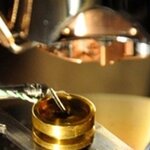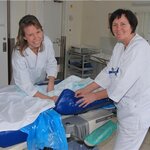Chemistry

Scientists say they can now tell the condition of an old book by its odor. In a report published in Analytical Chemistry, a team of researchers describe development of a new test that can measure the degradation of old books and precious historical documents on the basis of their aroma. The non-destructive "sniff" test could help libraries and museums preserve a range of prized paper-based objects, some of which are degrading rapidly due to advancing age, the scientists say.
The new technique — an approach called "material degradomics" — analyzes the gases emitted by old books and documents…
Did someone mention Elvis? This research made the cover of ACS's Journal of Physical Chemistry in color.
The diatomic cyanide ion CN− is released sometimes by the chemical compounds that contain the cyano group C≡N. Figures 1 and 2 of the researchers show the subject of this paper, the barbell-shaped cyanide ion interacting with the boomerang-shaped water molecule in gas phase. Xue-Bin Wang and team reported the first gas phase spectroscopic studies ever on CN-(H2O)n clusters, where n=1 to 3. They presented in detail a joint…
Sustainability stretches through greener chemistry. Imagine having a choice in designing environmentally friendly materials. This opportunity is presented in "Identifying the Molecular Origin of Global Warming" scheduled for the November 12's ACS Journal of Physical Chemistry. The approach taken by Partha Bera et al. seeks to explain how fundamental properties influence molecular absorption in the atmospheric window. What are the major factors that make some molecules more effective greenhouse gases (GHGs)?
Is it possible, for…
The periodic table has been covered in myriad ways on this site1, but no one has addressed the re-setting of the venerable Table. I was reminded of this slightly consternating activity this morning while reading Technology Review's arXiv physics blog on a new graphical representation of the Periodic Table.2
I like the flat, 2D familiar table. Nostalgia and comfort likely play a role in that. So I don't know how I feel about the newly shaped tables out there.
So, asks arXiv, why change it? "According to Mohd Abubakr from Microsoft Research in Hyderabad, the table can be improved by arranging…
Soon the world will learn who won the 2009 Nobel Prize in chemistry. Do you remember Peter Agre and Roderick MacKinnon of the following announcement?
The Nobel Prize in Chemistry 2003
The Royal Swedish Academy of Sciences has decided to award the Nobel Prize in Chemistry for 2003 “for discoveries concerning channels in cell membranes”, with one half of the prize toPeter AgreJohns Hopkins University School of Medicine, Baltimore, USA“for the discovery of water channels”and one half of the prize toRoderick MacKinnonHoward Hughes Medical Institute, The Rockefeller University, New York, USA“for…

University of Nottingham scientists have overcome a significant challenge for electrochemists - a way of probing right into the heart of an electrochemical reaction, a breakthrough that will help scientists understand how catalysts work and help create even better catalysts.
They were able to study the reaction at the point where the solution touches the surface of the metal electrode bringing in the electricity using spectroscopy under ultra high vacuum.
Because catalysts, materials used to create a chemical reaction, are dissolved in a solution it is often very hard to understand why…
The ultimate do-it-yourself and hack-your-way-to-happiness magazine, MAKE, recently launched a new section to their Make:Online website just for supporting the at home citizen scientist.
Having just subscribed to the online version of the magazine, I am excited to see the additional resources that Make is developing to actually support the education of amateur scientists with this guide for entering into the world of science at home. The focus at this time is on at home chemistry projects, and will help you take your old children's chemistry set experience to the next level in your garage (or…

Astrid Skreosen worked for many years as an auxiliary nurse in the maternity ward in Skien Hospital and became fed up with the little mats which were supposed to lie under women who were giving birth that were intended to soak up waste products and fluids so she began to look into the possibility of producing a specially modified super-absorbent bed sheet.
After stumbling around in the dark for a while with inventors’ consultants and patent offices, she rang SINTEF (Skandinavias største uavhengige forskningsorganisasjon) Materials and Chemistry and spoke with Per Stenstad.
“Restless women in…

One component of interstellar clouds emitting unusual infrared light known as the Unidentified Infrared Bands (UIRs) is a gaseous version of naphthalene, the chief component of mothballs back on Earth, according to research led by Michael Duncan, Regents Professor of Chemistry at the University of Georgia, along with doctoral student Allen Ricks and Gary Douberly, now an assistant professor in the department of chemistry at UGA.
The UIRs have been seen by astronomers for more than 30 years, but no one has ever identified what specific molecules cause these patterns.
The discovery that…